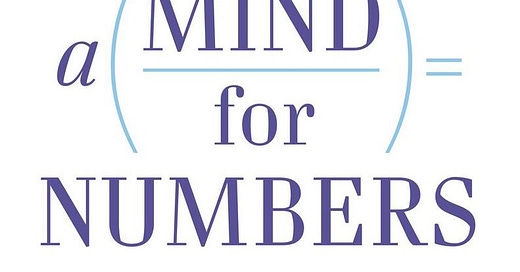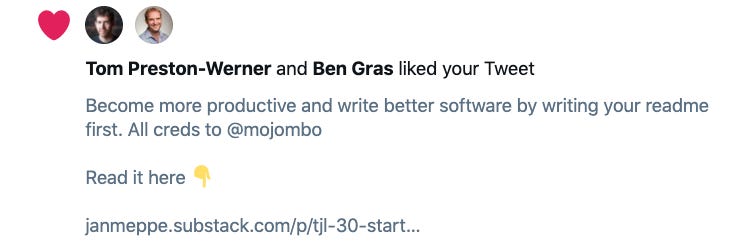TJL #31: Work with an outline (Daily productivity #6)
Simple tips & tricks to be more productive
Welcome back to Today Jan Learned (TJL) #31. In this newsletter I share the best of what others have figured out already. To get these delivered straight to your inbox, subscribe now
Key insight:
Be more productive by structuring your creativity with an outline
Quick Public Service Announcement (PSA):
Tom Preston-Werner, co-founder and ex-CEO of Github, liked my freaking tweet. I can die in peace now.
If you are a very chaotic person, like me, try to working with an outline. I found this practice to be very beneficial for my productivity.
Creativity is like lightning, powerful yet unwieldy. Use an outline as a lightning rod to guide it where you want it to go.
A Mind For Numbers
What I want to share with you today is from A Mind for Numbers: How to Excel at Math and Science (Even If You Flunked Algebra).
This book is probably my favourite book in the world.
While I was still studying, this book turned out to be invaluable. It teaches you how to study effectively and excel in math and science. The content is deeply rooted in science but presented in a fun and engaging manner with tons of pictures and stories.
One of the tips in the book is to “prime your mental pump” before starting to read a chapter or section.
Prime your mental pump
As you first begin looking at a chapter or section of a book that teaches concepts of math or science, it helps to take a “picture walk” through the chapter, glancing not only at the graphics, diagrams, and photos, but also at the section headings, summary, and even questions at the end of the chapter, if the book has them. This seems counterintuitive—you haven’t actually read the chapter yet, but it helps prime your mental pump. So go ahead now and glance through this chapter and the questions at the end of the chapter.
You’ll be surprised at how spending a minute or two glancing ahead before you read in depth will help you organize your thoughts. You’re creating little neural hooks to hang your thinking on, making it easier to grasp the concepts.
When you are reading something for the first time, try going over the whole thing in broad strokes first. This creates “neural hooks” (an outline) for your brain to hang your thinking on. But what happens when we invert this concept?
Make an outline
If you read better with an outline, does an outline make us write better? I found that this is indeed the case, for me.
I am a very chaotic person. Instead of letting this chaos take over my life, I force myself to make outlines, plans, and schedules. Within the boundaries of these outlines I can be as chaotic and creative as possible, but that’s it.
This is an example of one such outline. Note that there is absolutely no pressure to get the outline right the first time. You are free to change it at will. All that is required of you is to think of some structure to guide your creativity.
Also, behold my continued love for checkboxes, read more about that here: TJL #26: Use a checkbox (Daily Productivity #1).
How you can apply this idea
When you write your next email, first create an outline for yourself: Greeting, header, main points, main arguments, conclusion, signature.
When you write your next blog post, first create an outline for yourself: Greeting, main points, arguments, conclusion, call-to-action.
The next time you do anything creative, first create an outline for yourself.
Remember that there is no pressure to get it right, what matters is that you have some form of outline. These outlines are like self-imposed restrictions, within which you can go absolutely bonkers.
Works for me, hopefully it works for you too!
Thank you for reading!
That was today’s issue of the Daily Productivity Newsletter 🚀
Daily Productivity is a newsletter in which I share practical and effective tips on how to become more productive.
I collect these tips from the best self-help books, podcasts, videos, and turn them into immediately actionable tips for you to apply to your own life!
If you want to tag along for the journey, feel free to subscribe here!
As always, you can find me on my website janmeppe.com or on Twitter at @janmeppe.
Previous TJLs
Read my previous TJLs by following on the links down below:
TJL #6: How to remember the difference between margin and padding
TJL #7: According to Jeff Bezos there are two types of failure
TJL #27: Be aware of the spotlight effect (Daily productivity #2)
TJL #28: Start with the upper-left hand brick (Daily Productivity #3)
TJL #30: Start with writing your README (Daily productivity #5)





